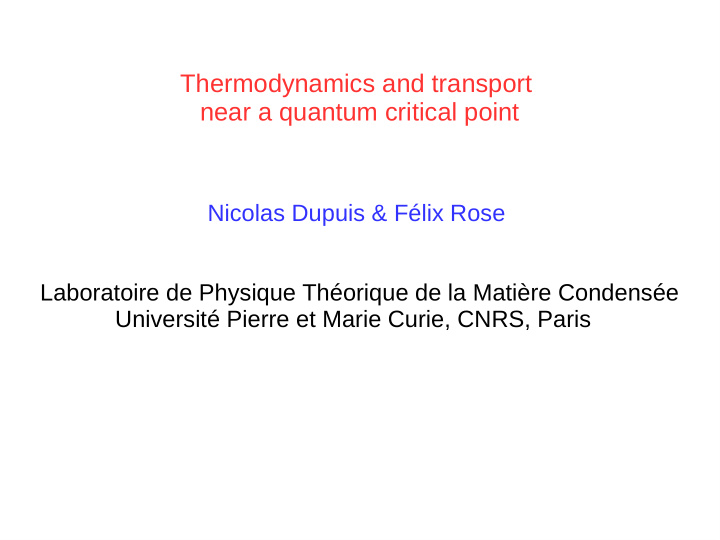



Thermodynamics and transport near a quantum critical point Nicolas Dupuis & Félix Rose Laboratoire de Physique Théorique de la Matière Condensée Université Pierre et Marie Curie, CNRS, Paris
Outline Introduction : (continuous) quantum phase transitions ● Thermodynamics near a QCP ● Conductivity near a QCP ●
T =0 quantum phase transitions – examples Transverse field Ising model ● paramagnetic ground state ferromagnetic ground state all spins aligned with h all spins parallel to z axis Interacting bosons (integer filling) ● insulating phase superfluid phase (localized bosons) (condensate)
2D quantum O( N ) model (bosons in optical lattices, quantum AFs, etc.) Lorentz-invariant action for a N -component real field with temperature-independent couplings T =0 : classical 3-dimensional O( N ) model ● QPT for r 0 =r 0c ; 3D Wilson-Fisher fixed point T >0 : energy scales: T and T=0 gap Δ, crossover lines: T ~Δ~|r 0 -r 0c | ν ● T Quantum Critical (QC) regime : QC physics determined by critical (2D, N >2) QD ground state and its thermal RC excitations 0 LRO
Method: nonperturbative functional RG [Wetterich'93] Derivative expansion ● Blaizot—Méndez-Galain—Weschbor approximation [Blaizot et al, 2006] ● LPA’’ [Hasselmann’12; Ledowski, Hasselmann, Kopietz’04] ●
What do we want do understand/calculate ? T =0 and T >0 universal properties near the QCP thermodynamics : ● time-dependent correlation functions ● (real time) conductivity ●
Benchmark test: thermodynamics Δ characteristic T=0 energy scale pressure entropy Rançon, Kodio, ND, Lecheminant, PRE'13
quantum-classical mapping 2D quantum system 3D classical system in at finite temperature finite geometry with periodic (equation of state) boundary conditions (Casimir effect) NPRG MC A. Rançon, L.-P. Henry, F. Rose, D. Lopes Cardozo, ND, P. Holdsworth, and T. Roscilde, PRB’16
Correlation functions Examples ● – o.p. susceptibility: – Scalar (Higgs) susceptibility: – Conductivity : Difficulties ● – Strongly interacting theory (QCP) – Frequency/momentum dependence – 2- and 4-point functions – Analytical continuation
Conductivity of the O(N) model O( N ) symmetry →conservation of angular momentum ● we make the O( N ) symmetry local by adding a gauge field ● current density ● N =2 (bosons) linear response theory ● conductivity tensor
The conductivity tensor is diagonal: ● has two independent components: ● in the disordered phase and at the QCP: ● For N =2, there is only one so( N ) generator and the conductivity in the ordered phase reduces to σ A
Universal properties T QC Low-frequency behavior: QD RC LRO (not much investigated as exists for N ≥3) [Fisher et al., PRL'89] Long-term objective: determine the conductivity in the QC regime (no quasi-particles → Boltzmann-like description not possible)
Objective: determine the universal scaling form of the conductivity ● Technically: compute 4-point correlation function Previous approaches ● – QMC (Sorensen, Chen, Prokof’ev, Pollet, Gazit, Podolsky, Auerbach) CFT (Poland, Sachdev, Simmons-Duffin, Witzack-Krempa) – Holography (Myers, Sachdev, Witzack-Krempa) – NPRG – DE (F. Rose & ND, PRB’2017) –
NPRG – LPA´´ Gauge-invariant effective action ● Gauge-invariant regulator ● [Morris’00, Codello, Percacci et al.’16, Bartosh’13] Conductivity ●
(Preliminary) results Universal conductivity at QCP ( N =2) ● QMC: 0.355-0.361 bootstrap: 0.3554(6) [Kos et al., JHEP’15] Universal ratio ● N =2: good agreement (~5%) with MC [Gazit et al.’14] Ordered phase ● is superuniversal N independent N =3 N =2 N =3 N =2
Frequency-dependence of the conductivity: ● – T =0: Padé approximant (work in progress) – T >0: analytical continuation from numerical data difficult when ω< T Strodthoff et al.: simplified RG schemes where sums over Matsubara – frequencies (and analytical continuation) can be performed analytically Pawlowski-Strodthoff, PRD’15 –
Conclusion Non-perturbative functional RG is a powerful tool to study QCP's. ● Finite-temperature thermodynamic near a QCP is fully understood ● – Universal scaling function compares well with MC simulations of classical 3D systems in finite geometry. – Pressure, entropy, specific heat are non-monotonous across the QCP; hence a clear thermodynamic signature of quantum criticality. Promising results for dynamic correlation functions (e.g. conductivity) ● but finite-temperature calculation still very challenging. – LPA’’ appears as the best approximation scheme to compute σ(ω). – Low-frequency T=0 conductivity well understood. σ B (ω) is found to be superuniversal. – How to perform analytic continuation at finite temperature?
Recommend
More recommend